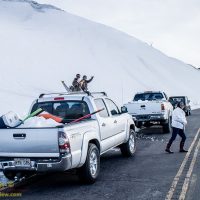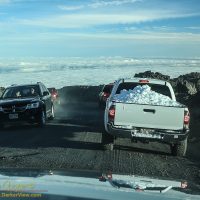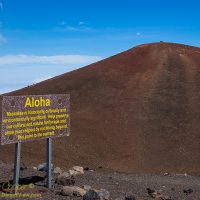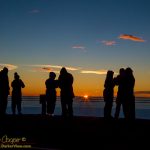There are days when it seems like the entire island population comes to Mauna Kea. This is certainly the case on a snow day, the first day the road is open after a fresh snowfall will see a crowd of folks ascending to the summit to play in the snow.

One local tradition is the hauling of snow from the summit to the beach. On some days dozens of pickup trucks can be found on the summit, or filled with snow making their way down the mountain road. The snow will be the basis of parties and games on the beach or in green tropical lawns. Online you can find photos of snowmen under palm trees or snowball fights and smiling keiki on Hilo yards.

The mauna is a place where everyone can go to enjoy the snow, enjoy the views, or enjoy the stars that shine so brightly here on a clear dark night. Not everyone shares this view of Mauna Kea, there is a smaller group that feels the mountain is also theirs, but would prevent others from enjoying the summit.
It is not unusual to see limitations suggested by many folks on either side of the current controversy. There are some who feel that access to the mountain should be limited somehow.
From my own personal experience on the mountain, with all the noise and crowding, I could not feel the same special feeling I felt the last time I was up there. It felt and still feels entirely wrong. It is a special place and we need to treat like a special place. – Governor David Ige
There is an even more extreme version of this to be found. Among the Hawaiian practitioners and others who feel it is “their” mountain you can find those who believe access should be limited to only those who share their religious beliefs.
Access to the present visitors center the should be limited to scientists and cultural practitioners . The summit should only be accessed by a small handful of the most significant people within those communities. – Kia Almeida in a Facebook comment
Once we gain victory…access to the summit must be monitored & vehicular access must be limited to preserve the aquifer & the sacred burial sites for ALL TIME!!!!! – Leigh Cidney Keonekaulana Case, Facebook Comment 10Dec2016
Claims of burials and religious site are often the excuse used to justify denying access to the summit to others. That might make sense if there were any burials at the summit, the nearest are quite some ways down the mountain and in places you have to hike to get to. There are no burials that are endangered by the current level of activity on or near the summit and the telescopes. There are accessible religious sites, usually ahu or stone altars, that can be easily reached if you know where to go. It is also clear that these are religious sites and they are generally left unmolested, visitors normally respect such things as they would a church or temple.
The entire subject of access limitation is fraught with issues. How do you determine who may and who may not travel to the summit community? Any attempt to limit access would rightly be subject to court action. Any limitation based on race or religious affiliation would almost certainly fail any legal challenge.

Just this month Haleakalā National Park has begun limiting the number of visitors who are allowed on the summit for sunrise. The number of vehicles is now limited to the number of parking spaces available, about 150, each morning by means of a reservation system.
It is clear that the summit is impacted by the number of people that go there. On the other hand that impact is limited to a fairly small area of the mountain in close proximity to the roadway. In some ways the summit protects itself, the altitude making it difficult to move any real distance from the road. Hike any distance from the road, even a hundred yards, and the signs of use diminish very quickly. Travel out of sight of the road it is possible to forget that anyone but yourself is on the mountain.

The rangers patrol the mountain every day, the first line of protection for the mauna. They monitor visitor activities, educate people on the issues, summon police, paramedics, or tow-trucks as needed. They pick up the trash, check cultural sites, and report any issues back to the OMKM board.
MKSS is the service and maintenance organization that cares for the infrastructure on the mountain. MKSS operates the visitor center, educating visitors on the safety and cultural issues that surround the mauna. It is MKSS crews that grade the road and plow snow when needed.
OMKM, MKSS, and the rangers can call upon the resources of the University of Hawaii when needed. UofH biologists monitor the flora and fauna of the mountain regularly, surveying populations of the endemic wēkiu bug, keeping an eye out for invasive species. Archaeologists are available to survey the summit and advise OMKM on proper preservation of the many historical sites on the mountain. Also part of OMKM is a council of volunteer cultural representatives, the Kahu Kū Mauna Council, advises OMKM on cultural issues.

The issue should be one of resource management. What level of activity can the mauna support? How many people are too many? Of course opinions vary wildly, there are those who feel the summit is overused and those who disagree. I should be up to biologists and resource management professionals to make the call. Not that I expect that to happen, everyone with any connection to Mauna Kea is voicing an opinion on this, sometimes very loudly.
In the end the summit is public property, it belongs to the people of Hawai’i, and in particular to those who live in its shadow. To bar those from the summit that see this as their mountain would cause a great deal of resentment in the local community. A snow day on the summit sees a large segment of this local community come to the summit.
Current usage of the summit can be managed and handled with good planning and the proper level of effort by MKSS and other local authorities. Perhaps future increases in use may require limits to be considered, but not yet.

